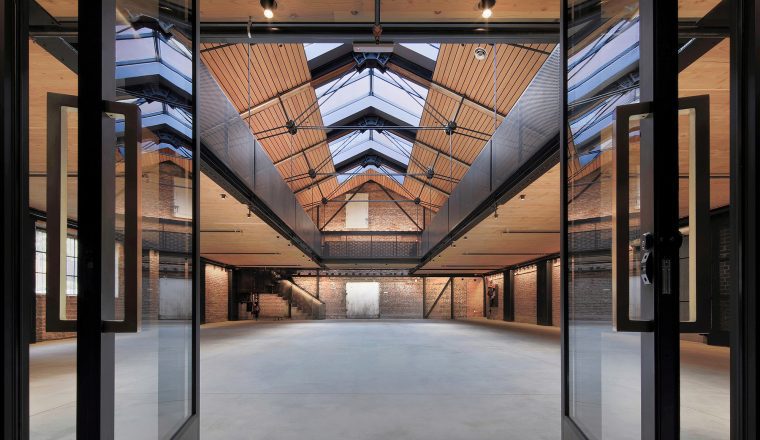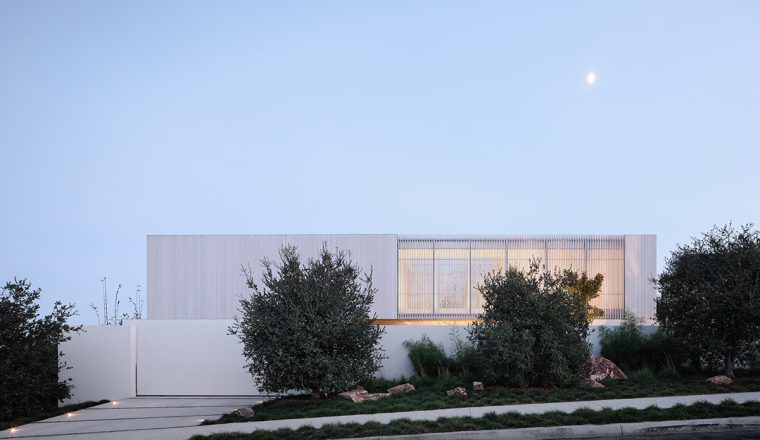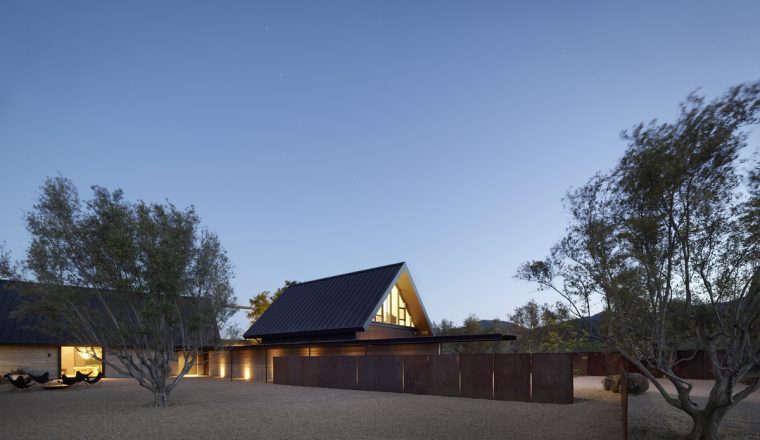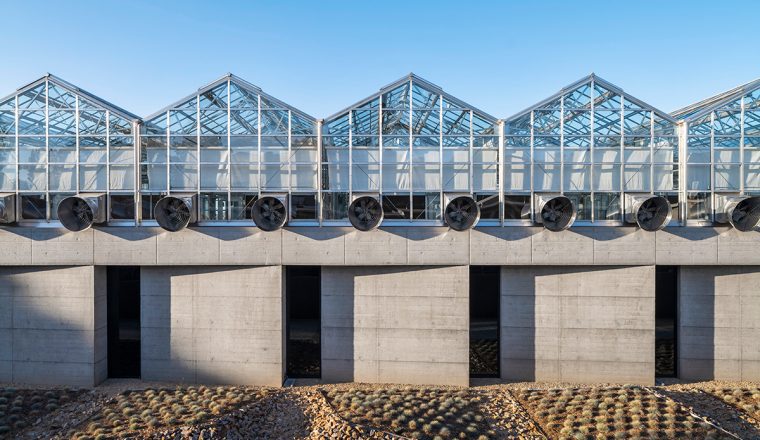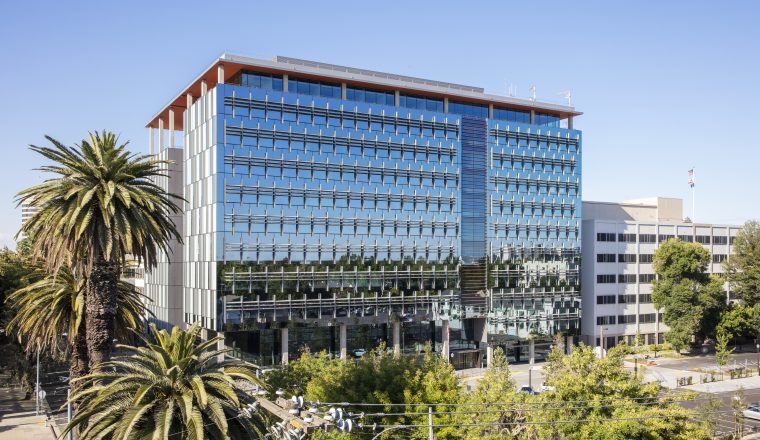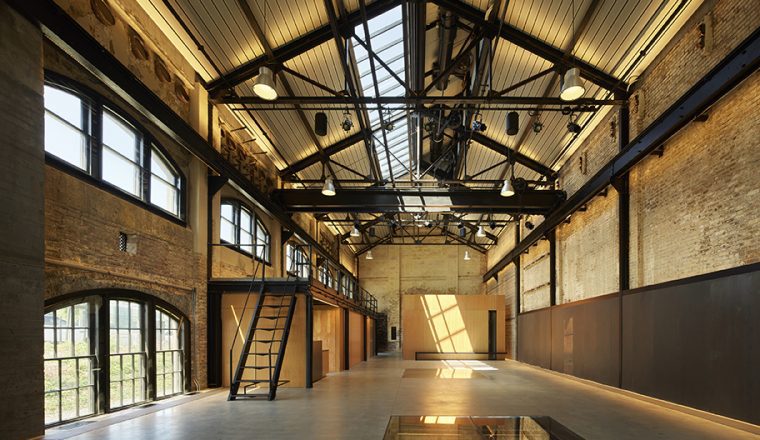2022 AIA CA DESIGN AWARDS
merit award
MacLac Building D
Architect: Marcy Wong Donn Logan Architects with PLAD Peter Logan Architecture and Design
Project Location: San Francisco, California
Photographer: Bill Hustace Photography
This project is the adaptive reuse of a historic brick structure occupied by various quasi-industrial functions. The renovation focuses on razing the maze resulting from a century-plus accretion of ad hoc partitions, random levels, and obsolete industrial equipment installations; exposing a previously hidden, magnificent volume of the building; repairing and refurbishing the original materials and features; reinforcing the building with 21st Century steel seismic elements, and bringing extra natural lights and open space.
”This handsome adaptive reuse project shows a well resolved and elegant seismic solution.” – 2022 Design Awards Jury
Design for Integration
The innovative steel ‘king post’ truss, perforated steel frames, and suspended Cross Laminated Timber partial second-floor structural design allow the building’s geometry and original wood and masonry to clearly read while providing seismic safety and additional leasable floor area. LEED v.4 Gold Certification building design aspects of the project are achieved in the areas of HVAC, recyclable and non-toxic materials, water-saving fixtures, abundant daylighting including skylight and windows, and high albedo roofing.
Design for Equitable Communities
In addition to exterior upgrades including new trees, sidewalk, crosswalks, etc. the community’s usability of the building is thanks to the structure’s full seismic upgrade which is visible only from the interior. A major seismic component is a cross laminated timber mezzanine structure suspended from highly refined king-post steel trusses.
The benefits of this project are a cleaner, more vibrant and safer neighborhood and the stimulation of economic vitality through job creation resulting from the metamorphosis of a decrepit, vacant shell into a seismically safe, architecturally upgraded building whose functions will both serve and provide jobs to the community.
Design for Ecosystems
The project has a high percentage of natives, but are also expected to be mixed with non-natives to meet tenant aesthetic expectations.
The landscape design of this project contributes to a healthy environment and ecosystem. The plant palette consists of many drought tolerant and California native plant species such as: Arctostaphylos ‘La Panza’ (Grey Manzanita), Carex tumulicola (Foothill Sedge), Epilobium canum (California Fuschia), Ceanothus ‘Yankee Point’, and many more. California native trees surrounding the site like the Arbutus ‘Marina’ provides habitat to birds. The bio-diverse selection of plants provide forage and refuge to hummingbirds, bees, moths, and many species of local pollinators throughout the seasons. The landscape at the ground level and the roof level delivers layers of benefits for the local ecosystem.
Design for Water
The project is a small sized adaptive reuse interior building renovation without a roof terrace, so there is no rainwater collection and storage. The site of the building goes from property line to property line, so there is no irrigation. There is only one 63 square feet ADA restroom inside the building using non -recyclable water. It is possible to reuse grey/blackwater inside the building due to different occupant.
Design for Economy
This project is designed to far surpass the standard level of adaptive reuse for functional objectives. It aims to create an architecturally uplifting atmosphere and historically responsible improvements, while simultaneously achieving numerous technical goals of energy efficiency, state of the art seismic resistance, environmental sustainability and ADA compliance. The innovative steel ‘king post’ truss, perforated steel frames, and suspended Cross Laminated Timber (CLT) partial second floor structural design allow the building’s geometry and original wood and masonry to clearly read while providing seismic safety and additional leasable floor area.
Design for Energy
LEED v.4 C+S Gold Certification aspects of the project are achieved in the areas of heating / ventilating / air conditioning, recyclable and non-toxic building materials, water saving fixtures, abundant daylighting (skylight and windows), high albedo roofing, accessibility to public transportation.
By using California’s Title 24-2019 for code compliance and ASHRAE 90.1-2010 for LEEDv4 C+S., both Code Compliance and Performance Models were performed.
To achieve higher levels of energy efficiency, the electric lighting is grouped into different zones which correspond to primary and secondary daylight harvesting zones (as defined in Title 24).
All light fixtures are equipped with full range dimming drivers and connected to dimming controls. Upon signal from the daylight sensors located throughout the various spaces, the drivers adjust the lighting to compensate for the amount of daylight penetrating the zone. The dynamic range of the drivers are 100%-1% and the system is capable of continuous dimming. Thus, as the daylight condition changes the system responds and changes to adjust the overall balance of light to appropriate ratios. In this way maximum energy efficiency is attained at any one time.
Design for Well-being
A major seismic component is a cross laminated timber mezzanine structure suspended from highly refined king-post steel trusses. Adding to the building’s usability by the community and visitors are completely new electrical, plumbing and HVAC systems.
The community will appreciate the types of uses and tenants that would avail themselves of this project’s design. A 60-foot-long skylight along the roof ridge daylights the formerly dark interior. Other modern insertions enhance the interior architecture and function: guardrails at and open stair of perforated metal at and to the mezzanine, European Oak mezzanine flooring; LED lit brick walls, wood slat ceilings.
Design for Resources
The project is using an existing historic building rather than building from the ground up. The resulting reduction in demolition waste as well as the reduction in carbon emissions from eliminated new structural and envelope materials is very significant. These reduction impacts are able to be quantified but those calculations are not currently intended.
We repurposed the old heavy timber top chords of trusses as spacers between steel channel top chords of symmetrical king post trusses on each side of the existing trusses, the new steel channel encapsulates the existing timber top chords leaving the bottom surface of the historic wood exposed.
Once the rods joining the two sides were installed, they could be tightened to adjust the height of the ridge assisting with aligning and leveling the old roof, and existing web members and bottom chords of the trusses could be removed leaving the light and elegant news trusses.
CLT floor slabs, designed for 100 psf assembly loading, form a mezzanine suspended by hanger rods dropped down from the kingpost nodes on the roof trusses, leaving a column-free lower level with an open center area that allows light from the new skylight to reach the entire lower level.
Design for Change
We rejuvenated and repurposed a 1906 warehouse to last another 100 years. The seismic resisting system for the rejuvenated building is an ultra-stiff moment frame system consisting of deep columns and beams formed with HSS acting as flanges and perforated steel plate acting as webs accommodating the punched windows on the long sides of the buildings, combined with stiff concentric braced frames on the gabled ends of the building.
All light fixtures are equipped with full range dimming drivers and connected to dimming controls. Upon signal from the daylight sensors located throughout the various spaces, the drivers adjust the lighting to compensate for the amount of daylight penetrating the zone. The dynamic range of the drivers are 100%-1% and the system is capable of continuous dimming. Thus, as the daylight condition changes the system responds and changes to adjust the overall balance of light to appropriate ratios. In this way maximum energy efficiency is attained at any one time.
Design for Discovery
The building is completed in May, 2022 and it haven’t been occupied yet, that why there is no post occupancy evaluation or occupant satisfaction survey conducted. But we will pay attention on the building usage in future and make improvement if needed. Generally, we hold meetings with clients and use questionnaire to collect needs and questions from clients/users to ensure the good condition of building and satisfaction of occupant.
A major seismic component is a cross laminated timber mezzanine structure suspended from highly refined king-post steel trusses. The benefits of this project are a cleaner, more vibrant and safer neighborhood and the stimulation of economic vitality through job creation resulting from the metamorphosis of a decrepit, vacant shell into a seismically safe, architecturally upgraded building whose functions will both serve and provide jobs to the community.

